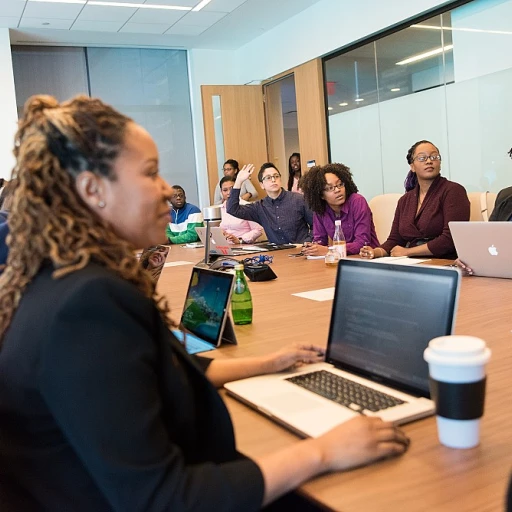
Understanding the Importance of Team Rules in Succession Planning
Establishing the Foundation for Smooth Succession
In the realm of succession planning, team dynamics play a crucial role. Effective team rules ensure that people within an organization work towards a common goal and foster a culture that is conducive to positive work environments. These rules help members understand definite roles and work tasks, promoting seamless transitions when leadership changes.
Team rules aren't just about telling employees what not to do; they are about establishing a framework that helps in communication and collaboration. Good teamwork is born from clear expectations, allowing team members to feel confident in their abilities and contributions. When these parameters are well-defined, members are more likely to engage, propose ideas, and participate toward achieving the organization’s goal.
The Role of Communication in Team Dynamics
One of the vital aspects of successful succession planning is maintaining open lines of communication between all levels of the team. Regular team meetings offer opportunities for team members to share updates, discuss challenges, and propose changes. It’s practice like this that creates an open change culture, where everyone is encouraged to voice their thoughts.
Communication also means converting meetings into productive discussions rather than a mere formality. The introduction of a 'parking lot' during meetings can help to capture important but off-topic ideas, ensuring that they don't distract from the primary agenda while still being acknowledged and addressed later.
Building a Strong Team Ethos
Strong team ethos is paramount for achieving successful transitions in leadership. When team leaders make a concerted effort to build unity and trust within their respective teams, it mirrors throughout the entire organization. Team building activities and clear, agreed-upon team rules empower members, enhance team work, and ultimately align the team’s efforts with the wider organizational goals.
Organizations that proactively craft these dynamics typically perform better during succession transitions. By focusing on communication, teamwork, and a supportive culture, businesses are better prepared for smooth changes in leadership structures.
Key Components of Effective Team Rules
The Building Blocks of Team Dynamics
Establishing effective guidelines for team dynamics is crucial in any organization. These guidelines not only facilitate communication among team members but also enhance a positive work environment. Let's delve into some key components that can make team rules more effective.- Clear and Definite Roles: Assign each team member a specific role that aligns with their skills and work tasks. This clarity allows employees to feel valued and improves teamwork by reducing overlaps and confusion.
- Open Communication Channels: Encourage team members to share ideas and feedback openly. Transparent communication is the cornerstone of teamwork and helps in achieving the common goal.
- Regular and Structured Team Meetings: Schedule regular meetings to discuss progress, address challenges, and share updates. This practice promotes a culture of accountability and helps keep everyone on the same page.
- Inclusive Decision-Making: Engage all team members in decision-making processes to foster a sense of ownership and collaboration. Inclusive practices help you harness diverse perspectives and are a hallmark of effective team dynamics.
- Implementation of a "Parking Lot": Introduce a "parking lot" method to capture ideas and suggestions that may not fit into the meeting agenda. This ensures that productive conversations continue without sidetracking meetings.
- Focus on Team Building: Prioritize team-building activities that enhance trust and camaraderie among members. Such activities contribute to a cohesive and motivated team culture.
Aligning Team Rules with Organizational Goals
Syncing Team Dynamics with Organizational Aspirations
When establishing team rules, aligning them with the organization's overarching goals is crucial. This synchronization helps ensure that each member of the team works not only towards common goals but also supports the larger objectives of the organization. To create rules that resonate with both team dynamics and organizational ethos, consider the following:
- Open Communication: Facilitate open dialogue among employees during team meetings. This practice helps team members feel included, encouraging them to share ideas that align with company goals. Effective communication can be the cornerstone of fostering a culture conducive to better succession planning.
- Defining Roles Clearly: Assign definite roles for each team member based on their strengths and the organizational needs. Clear direction eliminates overlap, reduces friction, and enhances team work, making team efforts more efficient and goal-oriented.
- Regular Reporting: Implement structured reporting within team dynamics. These reports update team leaders on progress, reinforce accountability among team members, and allow for adjustments if necessary to stay on track with organizational goals.
- Incorporating Flexibility: Teams should be encouraged to adapt and embrace open change, ensuring their rules can evolve alongside organizational shifts. This fluidity maintains a positive work environment and aligns with the organization's strategic shifts.
By weaving organizational goals into the fabric of team dynamics, teams not only operate more cohesively but also drive the broader mission of the organization forward. This approach reinforces a culture of teamwork while ensuring that everybody—from leaders to team members—operates with a shared purpose in mind.
Challenges in Implementing Team Rules
Overcoming Hurdles in Establishing Team Rules
Implementing effective team rules can transform a group of employees into a cohesive, productive unit. However, the path is rarely smooth, with several challenges emerging along the way. As organizations seek to build positive work cultures with open communication, navigating these obstacles becomes pivotal.
One major hurdle is achieving buy-in from team members. People often feel resistance to change, especially when it involves altering their usual work tasks or adopting new practices. Communication plays a critical role in easing this process. By fostering an environment where team members can freely express ideas and concerns, leaders can cultivate a sense of ownership, increasing acceptance of the new rules.
Team leaders should also address the diversity of work styles and personalities within their teams. Standardizing team rules can help, but they must be adaptable enough to accommodate individual preferences. This flexibility can ensure all members feel included and valued, ultimately supporting the organization's common goal.
A practical strategy involves establishing definite roles and clear expectations. When employees understand the purpose and implications of team rules, they are more likely to see their benefits and contribute effectively. Regular team meetings can act as a platform for discussing progress and challenges, allowing team members to suggest improvements or voice concerns.
Organizations may encounter the "parking lot" effect, where issues are noted during meetings but not addressed later. It's crucial for team leaders to follow up and ensure that all points raised are tackled, showing commitment to improvement and fostering trust.
The culture of the organization itself can also affect how easily team rules are implemented. If an open change mindset is encouraged, there'll be more willingness among teams to embrace new practices. Adjusting the organization's communication strategies and openness can enhance teamwork, leading to better outcomes.
In conclusion, overcoming these challenges requires a thorough understanding of team dynamics and a commitment to fostering positive, open relationships among team members. With the right approach, organizations can craft team rules that not only align with their goals but also enhance overall team productivity.
Case Studies: Successful Succession Planning Through Team Rules
Case Study Insights: Harnessing the Power of Team Rules for Succession Success
In the realm of succession planning, the incorporation of robust team rules plays a pivotal role in ensuring seamless transitions. Various organizations have successfully navigated succession planning by establishing and adhering to these guiding principles, emphasizing effective communication and teamwork. One particular organization enhanced its internal culture by introducing a set of clear and concise team rules. These rules were designed to foster open communication and cultivate a positive work environment, where every team member feels valued. The establishment of definite roles helped streamline work tasks and meetings, allowing the member team to focus on the common goal of a seamless transition. The organization reported increased team building and better collaboration as team rules became a part of the everyday team dynamics. Another organization tackled the common challenge of open change by embracing a diverse range of ideas during team meetings. By allowing the "parking lot" method—a practice where off-track ideas are noted but tabled for future discussion—they ensured every voice was heard, yet kept meetings on track. This not only facilitated better decision-making but also empowered teams, making team members feel their input was important in achieving the organization’s goals. Both organizations witnessed improved teamwork, as their team rules aligned with the broader objectives of the organization. Their cases underscore the importance of creating a structure where employees can thrive and adapt to new challenges, ultimately aiding in their succession planning endeavors. These real-world examples highlight that well-crafted team rules can boost employee engagement and drive successful succession planning initiatives. As teams prepare to face future trends, the ongoing practice of refining team dynamics will continue to support organizational growth and preparedness for leadership transitions.Future Trends in Team Rules and Succession Planning
Anticipating the Evolution of Team Rules in Organizations
As organizations worldwide adapt to ever-changing landscapes, the role of team rules in succession planning continues to evolve. This future-oriented approach not only addresses present-day challenges but also ensures that teams are well-prepared for tomorrow. Building on the foundation of clear communication, collaboration, and common goals, future team dynamics will likely emphasize:- Enhanced Digital Collaboration: With remote and hybrid work models gaining traction, digital communication tools will become integral. Successful teams will foster an open culture that encourages seamless exchange of ideas, enhancing teamwork and cohesiveness.
- Flexibility and Adaptability: As change becomes a constant, organizations will need to cultivate teams that are resilient and open to change. This may involve frequent updates to team meetings, roles, and rules to better align with dynamic goals.
- Inclusivity and Diversity: The importance of diverse team members cannot be overstated. Diverse perspectives contribute to innovation and problem-solving, offering a competitive edge in achieving organizational goals.
Moreover, organizations will continue to scrutinize their team rules, aligning them with broader organizational objectives while maintaining sensitivity to employee needs. This practice not only helps foster a positive work environment but also supports effective succession planning.
The future of team dynamics hinges on fostering environments where employees feel valued and empowered. Organizations must actively engage in team-building exercises that develop definite roles, improve how work tasks are assigned, and ensure every member team works towards a common goal. As these dynamics evolve, lessons learned from successful case studies will serve as invaluable guides for developing strategies that ensure smooth transitions and sustained success.












